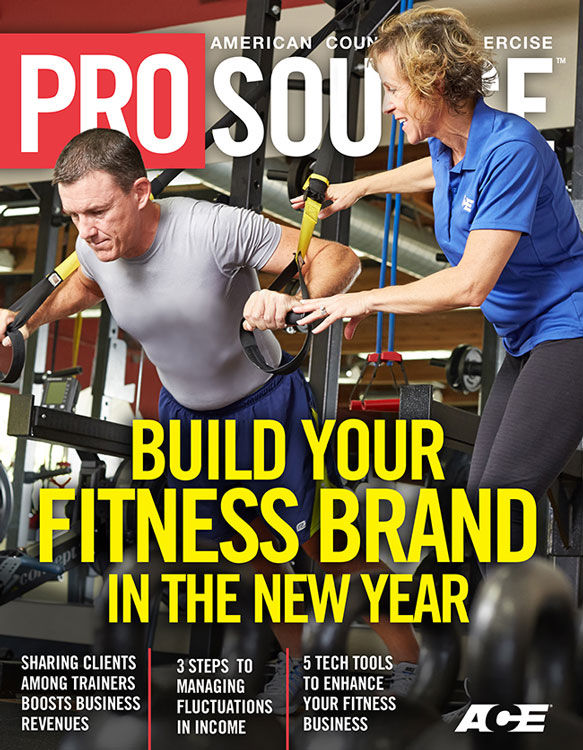
As America’s economy over the past decade has so clearly demonstrated, fluctuations in income and financial status are almost inevitable, whether it’s due to being upside down in a home loan, losing one’s job or even delaying retirement. Fitness professionals—whose financial stability is reliant upon the so-called “disposable income” of their clientele—would seem to be particularly prone to swift dips in income during tough economic times, but that’s not always the case.
“The fitness industry has traditionally been resistant to overall trends in the economy,” says Cedric X. Bryant, Ph.D., ACE’s Chief Science Officer. As such, while most fitness professionals can expect seasonal fluctuations in income, they probably don’t need to worry about the majority of their clients simply cutting fitness from their personal budgets and walking out of the gym.
Of course, one of the best things about being self-employed is the occasional jump in earnings that accompanies certain events, seasons or special promotions. In the fitness industry, the most profitable time of year is typically right after the New Year, when countless Americans are freshly committed to their resolutions. Depending on where they live and work, others may see a surge in clients at different times of the year when tourism is at its peak. Certain niche markets may also create considerable ups and downs; consider, for example, the personal trainer who works at a country club preparing recreational athletes for golf season.
The flipside of those financial boons is that, as those January fanatics turn into June dropouts, vacationers head back to the office and golfers take the winter off from training, your earnings begin to slide and you suddenly wish you’d done a better job of anticipating the change and had saved some of that extra money. The issue here—the ability to live with a varying income—is certainly not exclusive to the fitness industry. Everyone from commissioned salespeople to freelance writers will see fairly dramatic swings in income over the course of a year. Sometimes the difference between financial security and securing loans can be as simple as proper budgeting and forecasting. Live like royalty in January and February and you may find yourself struggling in the leaner months.

Rule number one to holding on to your clientele and reducing the fluctuations in income is: Focus on your regulars. If you make the mistake of catering to your new or seasonal clients first, at the expense of your reliable, year-round clientele, you could end up losing both groups when the resolutions wear off or tourist season ends. Fitness professionals working in areas with seasonal fluctuations in gym traffic should consider offering incentive programs to get locals in the doors during the slow seasons, because they are more likely to hang around for the long haul. It might even be a good idea to offer lower rates to locals, because they may have less disposable income than the people who stay in upscale ski resorts or beachfront retreats.
Another key to minimizing downward trends in income is proper forecasting. Fitness professionals should keep accurate records, not only of earnings, but also of class attendance and training schedules, throughout the year and use those records to forecast the same periods the following year. Accurate forecasting allows a deep understanding of one’s market and enables facility manages and owners to better put together staff schedules and, most important, serve their customers. In addition, you can use this information to anticipate “slow periods” and make the most of the time.
According to Jonathan Ross, ACE Fitness Expert and Senior Consultant Personal Training, the best tip for keeping income levels consistent is to make yourself indispensable. “Ensure that what you offer is of a high enough value that your clients view it not as a discretionary expense, but rather as an essential part of their health maintenance plan.” Dr. Bryant concurs, and recommends that fitness professionals also consider ways to offer more cost-effective services. For example, you may want to consider adding small-group training or boot-camp sessions to your repertoire, as these lower-cost options may help retain existing clients who may be considering pulling back on their training sessions.

This part of the equation possibly couldn’t be easier to say—or harder to do: Create a budget and stick to it. No matter how many finance books you read or blogs you follow, it all comes down to learning basic money-management skills and using them in your everyday life.
The most important thing to do when budgeting, for yourself or for your small business, is to always underestimate income and overestimate expenses. That way, you’ll either be prepared if things don’t go as well as you hoped or pleasantly surprised when you really do have some extra cash at the end of the day.
In addition, try to create a budget based on the leanest of months and see if you can sustain that throughout the year. If that seems realistic, then you’re in great financial shape, which means that the extra money you earn during your best months will be just that—extra. If it’s simply not possible, determine how much money you will need to get through each month and then figure out how much money you need to save from your busiest periods to pay your bills and live your life during the slowest.
Ross offers an additional tip: “I would recommend lowering the barriers to saving money for leaner times. For example, fitness professionals can make saving easier by setting up automatic monthly investments, even if it is to safer securities to keep the cash available when necessary. Having the money go out automatically—similar to what would happen for mortgage or rent payments or utility bills—will teach you to learn to live without that extra amount for everyday expenses. It is surprisingly easy to adapt to the change and this will steadily build up cash reserves for times when income and sessions dip.”

When asked about making good use of downtime, our experts provided answers that fell into two distinct categories: (1) Enhancing your education to improve yourself as a fitness professional; and (2) diversifying your offerings to take advantage of your strengths and outside interests.
Continuing Education
Continuing education is not only needed to maintain your ACE certification, it also is an essential aspect of making yourself more valuable to your clients and improving your overall business. Dr. Bryant recommends that fitness professionals “choose education that will help them either better serve their current profile of clients or enable them to work with a new population or niche that they want to reach.” For example, if you work in a family-oriented suburb and have been successful training healthy adults, continuing education can empower you to start an after-school program working with kids, thereby enabling you to serve the entire family. “Another good option is to use continuing education to specialize,” says Dr. Bryant. For example, a personal trainer who works with older adults may want to attend seminars on training individuals with arthritis or other orthopedic concerns.
The most ambitious continuing education option entails earning a second certification—for example, a personal trainer can expand his or her offerings by earning a health coach certification as well, and earn continuing education credits (CECs) in the process. A less grueling, but also extremely valuable, option involves earning a specialty certification in an area of interest such as youth fitness or fitness nutrition. Finally, fitness professionals can earn their CECs by studying any of a broad range of topics, from major cardiovascular diseases and disorders to fitness facility management. Whether you prefer workshops, webinars or symposiums, the point is that there is no such thing as downtime if you take advantage of all the educational opportunities the fitness industry has to offer.
Visit www.ACEfitness.org/continuingeducation to explore your many options, including earning a second certification or specialty certificate, attending an ACE symposium and completing any of the hundreds of online courses available. Another great tool for fitness professionals is Evolution Nutrition which helps solve an ongoing problem for many in the fitness industry: how to provide credible, research-based nutrition information and meal planning to clients without overstepping one’s scope of practice.
Diversification

Six Money Management Tips Everyone Can Use
1. Always know where you stand. Do a financial check-up often—at least every three months, and once a month if you are in debt.
2. Know yourself. It’s important to be honest with yourself when creating a budget. Don’t over-restrict your spending or you’ll likely find yourself unhappy with your day-to-day lifestyle, or you’ll be beating yourself up for not sticking to budget that wasn’t reasonable in the first place.
3. Know where every bit of your money goes. Track small expenditures as carefully as you monitor the big ones, both inside and outside of your business. Look for trends and places to save. And don’t forget about those once-a-year expenditures that seem to surprise you time and time again.
4. Question everything you spend. Is there a way to eliminate the expense? Or is there room to save?
5. Understand the difference between good debt and bad debt. Good debt can include investments in your business or in your education and professional development.
6. Be insurance savvy. Know—and get—the types of insurance you need to protect yourself, your business and your family. Do your research.
Elizabeth Kovar, M.A., a trainer, writer, presenter and ACE Master Trainer, offers some great advice for finding your niche. “Trainers should ask themselves, ‘Is there a solution to a current problem or gap that I can fill?’ Many fitness professionals do not come from an exercise science background, but may have studied business, engineering or art. They need to ask themselves if they can use their skillset or passion in the industry. For example,” Kovar continues, “a software engineer turned personal trainer can develop a fitness app or online magazine. Or a photographer can freelance his or her photography skills to gyms or publications.”
The real key is to identify your strengths and combine them with your passion to create your ideal career. For Doug Balzarini, owner of DB Strength and Head Strength Coach for Alliance MMA, that passion turned out to be training mixed martial arts (MMA) athletes. While the sport may not have the seasonal issues of other sports—these athletes train and compete year-round—Balzarini found it very tough to build a lucrative business around the sport. “Many of these professional athletes have second jobs just to make ends meet, so they aren’t able to pay much for training sessions.” Balzarini balances his passion with traditional personal training for the general population. “I honestly treat these two roles—strength coach and personal trainer—as two distinct jobs,” says Balzarini. “To deal with the common seasonal fluctuations that tend to occur with traditional personal training, I’ve tried to diversify my revenue streams. I currently offer a couple of DVDs, I speak at conferences around the country and I provide my own workshops a few times throughout the year.”
San Diego–based owner of In Health and Happiness, Holli Clepper, has found a way to integrate her love of travel into her career. Many fitness professionals don’t realize how many opportunities exist to share their expertise with others in the industry. Clepper travels to teach workshops to other fitness professionals at studios or YMCAs, which she says is a great way to network while also earning some extra money. You may be able to take advantage of downtime in your area by traveling to another location with different opportunities. Clepper suggests establishing yourself as an expert in a certain niche and then calling fitness coordinators at facilities in your target locations to explain what you have to offer.
Clepper also works with FitBodies, Inc. to enable herself to stay in resorts she otherwise may not be able to afford. “Traveling with FitBodies, Inc., is a great way to travel with my family to an all-inclusive resort for minimal costs.” While you will still have to pay for airfare and taxes, FitBodies offers a free stay in exchange for teaching classes—a great perk for anyone who loves to travel.
As Kovar suggests, “it’s good to have a big picture in mind, but its best to start small with one step, excel at it and move forward. Start with one idea, and then grow and capitalize on that strength. For those who want to reach outside the gym it is best to start local and gradually expand to regional, national and international markets for various projects.”
Whether your ultimate ambition is to give back to the local community by developing a fitness-based summer camp, travel the world while spreading the word about exercise, write a best-selling fitness book or train world-class athletes, knowing your strengths and seizing opportunities are the keys to long-term success in the fitness industry.





 by
by 






